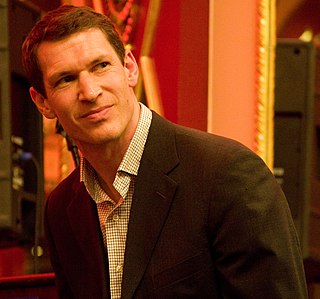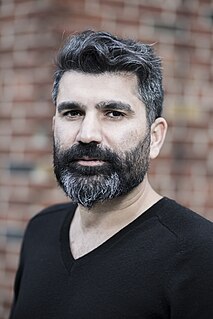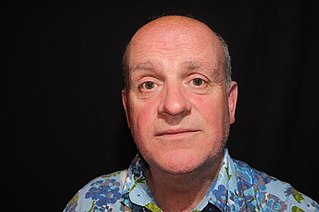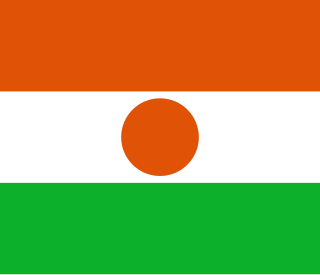
A refugee camp is a temporary settlement built to receive refugees and people in refugee-like situations. Refugee camps usually accommodate displaced persons who have fled their home country, but there are also camps for internally displaced persons. Usually refugees seek asylum after they've escaped war in their home countries, but some camps also house environmental- and economic migrants. Camps with over a hundred thousand people are common, but as of 2012, the average-sized camp housed around 11,400. They are usually built and run by a government, the United Nations, international organizations, or NGOs. There are also unofficial refugee camps, like Idomeni in Greece or the Calais jungle in France, where refugees are largely left without support of governments or international organizations.
Robert "Bob" Carlos Clarke was a British-Irish photographer who made erotic images of women as well as documentary, portrait and commercial photography.
FilmAid International is a non-profit humanitarian organization that uses film to educate and entertain displaced people around the world. FilmAid was founded during the Balkan crisis in 1999 by producer Caroline Baron to assist with refugee communities in Macedonia suffering the effects of war, poverty, displacement and disaster. Since 1999, FilmAid has worked in partnership with the United Nations High Commissioner for Refugees (UNHCR) and other global aid organizations to help bring information and training to more than two million people worldwide. FilmAid produces and distributes community-based films on public health and safety issues such as maternal health, HIV, cholera, gender-based violence and conflict resolution. Using inflatable screens and other ‘Mobile Cinema’ units, FilmAid screenings aims to overcome language and literacy boundaries. FilmAid currently works in Kenya, in the large refugee camps of Dadaab and Kakuma as well as informal settlements in Nairobi and Mombassa, with Burmese refugees in Thailand and also in Haiti. FilmAid is a global federation of nonprofit, charitable organizations. Members include FilmAid International, FilmAid Asia, FilmAid Kenya, and FilmAid U.K.

Timothy Alistair Telemachus Hetherington was a British photojournalist. He produced books, films and other work that "ranged from multi-screen installations, to fly-poster exhibitions, to handheld device downloads" and was a regular contributor to Vanity Fair.

Yannis Behrakis was a Greek photojournalist and a Senior editor with Reuters.
Maciej Dakowicz is a Polish street photographer, photojournalist and gallerist. He is from Białystok in North East Poland. Dakowicz is best known for his series of photographs of Cardiff night-life titled Cardiff after Dark. He and others set up and ran Third Floor Gallery in Cardiff and he is a member of the In-Public street photography collective.
Alex Majoli is an Italian photographer known for his documentation of war and conflict. He is a member of Magnum Photos.

Hossein Fatemi is an Iranian photojournalist. He received the 2nd place World Press Photo Award in 2017, and the Picture of the Year International (POYi) in 2016 and 2014 in two categories. He is member of Panos Pictures since 2010.

Giles Duley is an English portrait and documentary photographer. He is best known for his work documenting the long term impact of war.
Peter Dench is a photojournalist working primarily in advertising, editorial and portraiture photography. His work has been published in a number of his own books, exhibited and won awards.

Mishka Henner is a Belgian artist living and working in Manchester, England. His work has featured in several surveys of contemporary artists working with photography in the internet age. He has been described by some as a modern-day Duchamp for his appropriation of image-rich technologies including Google Earth, Google Street View, and YouTube, and for his adoption of print-on-demand as a means to bypass traditional publishing models.
Teun Voeten is an international photojournalist and cultural anthropologist specializing in war and conflicts. In 1996 he published the book Tunnelmensen about the homeless people living in an old rail road tunnel in Manhattan. He wrote also books on the war in Sierra Leone and made a photo book on the drug violence in Mexico, on which subject he wrote a PhD thesis at Leiden University.
Melanie Friend is a photographer/artist and Reader in Photography in the School of Media, Film and Music at University of Sussex, England.

Paul Reas is a British social documentary photographer and university lecturer. He is best known for photographing consumerism in Britain in the 1980s and 1990s.
Leila Alaoui was a French-Moroccan photographer and video artist. She worked as a commercial photographer for magazines and NGOs and completed assignments on refugees. Her work was exhibited widely and is held in the collection of Qatar Museum. Alaoui died from injuries suffered in a terrorist attack in Ouagadougou, Burkina Faso.
Marilyn Stafford is a British photographer. She worked mainly as a freelance photojournalist based in Paris in the 1950s and early 1960s, then in London, travelling to Lebanon, Tunisia, India and elsewhere. Her work was published in The Observer and other newspapers. Stafford also worked as a fashion photographer in Paris, where she photographed models in the streets in everyday situations, rather than in the more usual opulent surroundings.
Carla Borel is a French-British photographer. She has made portraits and black and white street photographs in Soho, London.
Sophie Gerrard is a Scottish documentary photographer whose work focuses on environmental and social themes. She is currently a lecturer at Edinburgh Napier University and a member of the board of trustees for Impressions Gallery in Bradford.














